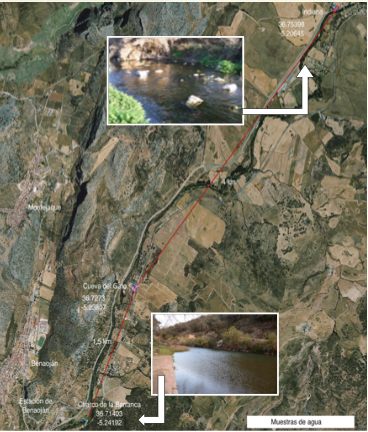Climate Detectives Projects 2021-2022
Project title: The regenerative capacity of the Cueva del Gato
Team: The regenerative capacity of the Cueva del Gato
IES Martín Rivero Ronda Spain 14 Student’s age: 14-15 years old
Can river water self-purify?

The Guadiaro river runs through various areas. Among them are the towns of Benaoján, Montejaque and other towns in the Serranía de Ronda. These towns share a problem: they lack a sewage treatment plant. In certain areas the water quality is not adequate. The contributions of water to the river behave as regulators of the concentration of dissolved substances, allowing the diversity of life forms that a river entails. We wanted to check the influence of the contributions by carrying out some experiments on water samples taken at different points. In our case we chose the Indiana and the Benaoján Station, since between them is the Cueva del Gato.
The objectives that we have proposed in this project are:
– Make the population aware of the contamination and poor state of the water, and above all try to take measures to prevent this worsening of the quality of the water.
– Carry out the experiment and really check which of the two waters extracted from different points is more contaminated. And make known which water is more polluted and therefore draw conclusions and measures.

The water of rivers and lakes is frequently affected by municipal wastewater without purification treatment, runoff from streets, buildings and gardens, etc…
Water quality can be determined by quantitative analysis in the laboratory, such as pH, conductivity, and microbial contamination.
With a previous study of the situation in the Guadiaro river area, two sample collection points were established. The resources available to the center’s laboratory marked the selection of the parameters and/or properties that would be determined from the samples. The chosen properties and parameters were: pH, measurement of dry residue (gravimetric method), conductivity, alkalinity (carbonates and hydrogen carbonates), hardness, phosphates (colorimetric method) and nitrates (colorimetric method).
Several repetitions were made in each of the determinations and the arithmetic mean of the values obtained was taken as the value.
The results of the measurements of the properties of the water samples taken, show that the entrance of water through the Cueva del Gato, between the Indiana Station and the Benaoján Station, influences a decrease in the concentration of dissolved substances, and consequently an increase in water quality.
The results obtained show that the contribution made by the Cueva del Gato is essential to maintain the quality of the Guadiaro river water, counteracting the high concentrations of dissolved substances in the water.
To maintain and/or improve the river water quality index, it is essential to protect the water supplies (groundwater) that the rivers receive.
The possible solutions to the absence of sewage treatment plants are the following:
– Making the population aware of the value of having a river with clean water is an essential task so that, in the future, it does not become a problem.
– Require the responsible administration to strictly comply with the regulations applicable to rivers and groundwater.
https://docs.google.com/presentation/d/1KfVEU5Ww13dNnCl_LDeWH0AjV7l0CDNI_jyd7ZgvOCI/edit?usp=sharing
Projects are created by the teams and they take the full responsibility of the shared data.
← All projects




